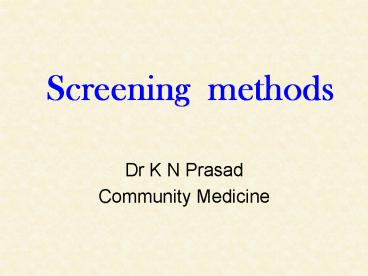Screening methods - PowerPoint PPT Presentation
1 / 20
Title:
Screening methods
Description:
Screening methods Dr K N Prasad Community Medicine Diseases are having iceberg phenomenon Screening is the early detection of disease precursors to disease. – PowerPoint PPT presentation
Number of Views:140
Avg rating:3.0/5.0
Title: Screening methods
1
Screening methods
- Dr K N Prasad
- Community Medicine
2
- Diseases are having iceberg phenomenon
- Screening is the early detection of disease
precursors to disease. Or susceptibility to
diseases in individuals who do not show any signs
of the disease - Tests
- Questions
- Examinations
- Laboratory tests
- X rays
3
- Definition The PRESUMPTIVE identification of
UNRECOGNIZED disease or defect by the application
of tests, exams or other procedures which can be
applied RAPIDLY to sort out apparently well
persons who PROBABLY have a disease from those
who PROBABLY do not. - Screening refers to the application of a medical
procedure or test to people who as yet have no
symptoms of a particular disease, for the purpose
of determining their likelihood of having the
disease. - The screening procedure itself does not diagnose
the illness. - Screening test will need further evaluation with
subsequent diagnostic tests or procedures.
4
(No Transcript)
5
Differences
- Screening test
- Done on apparently healthy
- Applied to groups
- Based on one or cut off criteria
- Less accurate
- Not a basis for treatment
- Initiative comes from the health agency
- Diagnostic test
- Done on those with sick or indications
- Applied to single patient
- Based on evaluation of number of symptoms, signs
or lab tests - More accurate
- Basis for treatment
- Initiative comes from patient with complaint
6
Lead time concept
- Time lag present between disease onset and usual
time of diagnosis
Final critical point
Usual time of diagnosis
Disease onset
First possible detection
outcome
A
Screening time
B
Lead time
Lead time is the period between diagnosis by
early detection and diagnosis by other means
7
Screening pathways
- Healthy
- Disease or precursor
- Detectable
- Symptoms develop
- Advance disease
- Death
Screening possible Intervention to avert
disease development or its consequences Life
prolonged
8
Objective
- The goal of screening is to reduce morbidity or
mortality from the disease by detecting diseases
in their earliest stages, when treatment is
usually more successful. - Sort out the population who has risk from others
- Examinations
- Pap smear, Mammogram, Clinical breast exam, Blood
pressure determination, Cholesterol level, Eye
examination/vision test, and Urinalysis.
9
Uses of screening tests
- Cases detection (Prescriptive )
- Screened primarily for their own benefit Ex.
Neonatal, cancers - Control of diseases (Prospective)
- Screened for benefit of others
- Ex. STD, TB
- Research purpose
- May aid in obtaining basic knowledge about
natural history of disease - Education opportunity
- To create public awareness and educating health
professionals
10
Types of screening
- Mass screening
- Screening afford to all irrespective of the
particular risk Ex. TB - High risk or selection screening
- Applied to selective high risk group on the basis
of epidemiological research - Ex. Cervical Cancer, heart diseases
- Multi purpose screening
- Application of two or more tests in combination
to a large number at one time - Ex. Questionnaire, examination, laboratory tests
etc.
11
Criteria for population based screening
- Knowledge of disease
- Condition must be an important problem
- Presence of recognisable latent or early
symptomatic stage - Natural history of the condition must be
adequately understood - Feasibility of screening procedures
- Suitable test or examination
- Acceptable to the population
- Should be a continuous process
12
Contd.
- Diagnosis and treatment
- acceptable treatment with recognisable disease
- Facilities for diagnosis treatment should be
available - agreed upon policy to treat as patients
- Cost considerations
- adequate resources
- Expected benefit
13
Principles
- Condition should be an important public health
problem - There should be a recognizable early or latent
stage - There should be an accepted treatment for persons
with condition - The screening test is valid, reliable and
acceptable yield - The test should be acceptable to the population
to be screened - The cost of screening and case finding should be
economically balanced in relation to medical care
as a whole
14
Screening tests
- Acceptability
- Simple, minimum pain or discomfort, easy, safety,
rapidity , acceptable procedure, etc. - Repeatability
- Must give consistent result when repeated several
times on the same subject or individual - Observer variation
- Biological variation
15
Observer variation
- Intra observer or within observer variation
- Measurements should be same( subject or material)
if recorded several times at that time or event - Ex. Ht, wt, lab tests. etc..
- Inter observer variation or between observer
variation - Differences in measurements on the same (
subject or material) by different investigators - Ex. X ray, blood smears, organisms, etc..
16
Biological variation
- Variation in physiological variables. Ex. BP,
Rates, etc. - Changes in parameters observed
- Ex. MI, Cancers, etc
- Variations in their symptoms /signs
- Memory, pain, quality of care, etc.
- Regression to the mean
- Tendency of values merge at the mean.
- This is tested by repeated observation over time
17
Thought for the day
- Every job is a self portrait of the person who
did it. - Autograph your work with excellence.
18
Thank you
19
(No Transcript)
20
Difference
- Screening test is intended for initial
examination. - Diagnosis involves confirmation of presence or
absence of disease in someone suspected or at
risk for having a disease. - Case finding measures































